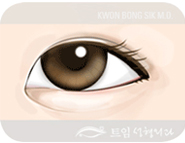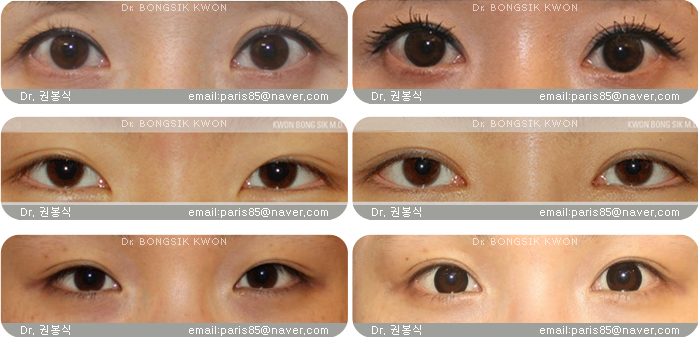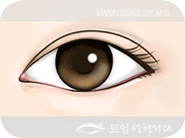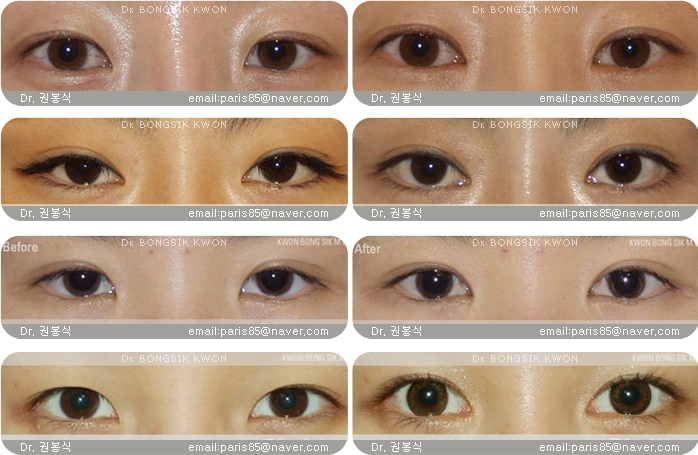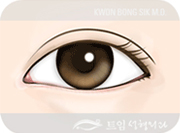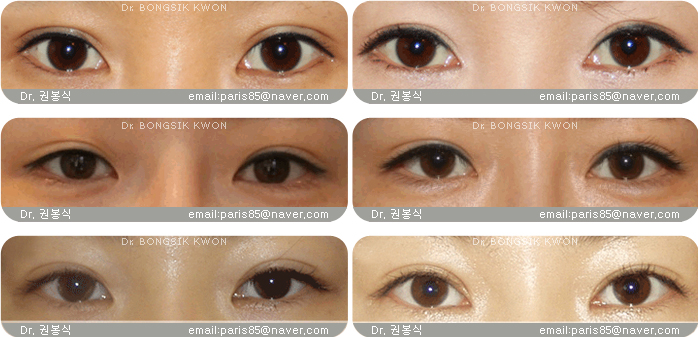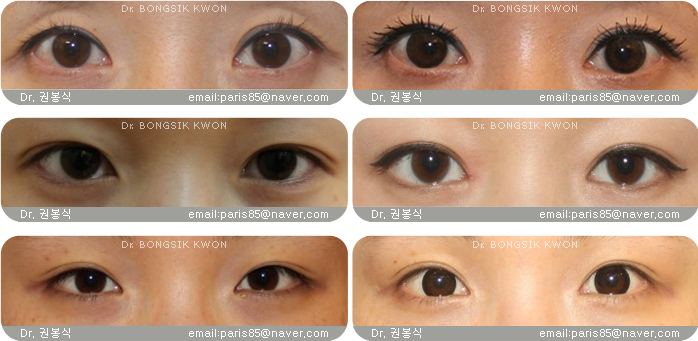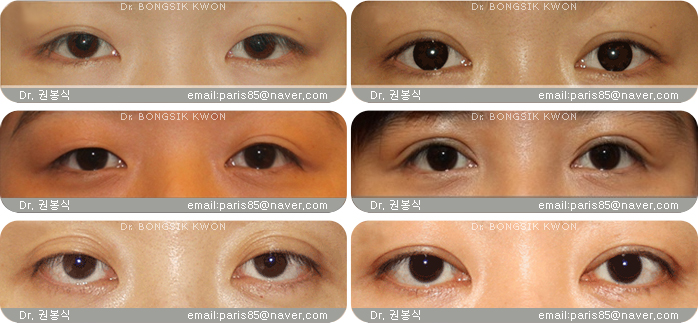An inner fold is a shape of the natural double eyelid of Asian, which is very low, formed close to the eyelash. It is almost invisible.
Infold double eyelid
An infold is a shape of the natural double eyelid of Asian, which is most general for northeast Asians in relation to the anatomical structure around the eyes. The medial eyelid crease is hidden by various amount of coverage by the epicanthus and looks thin and only noticeable in the mid-lateral eyelid. If the epicanthus is severe, the epicanthoplasty may be needed to improve severe infold crease.
Examples) Performing only double eyelid surgery on these kinds of eyes renders them have infold type eyelids
Examples) Slight improving of infold crease ,slight amount of inner corner exposure by magic epicanthoplasty in severe infold type eyelids.
Examples) converting of infold crease to inout-fold by magic epicanthoplasty and partial correction of medial crease with non-incisional anchoring
Examples) Structural double eyelid surgery combined magic epicanthoplasty and double eyelid surgery for parallel type of double eyelid.
Inout-fold double eyelid
Inout-fold double eyelid (tapered type)
An inout-fold is the middle form between an infold and an outfold. The crease starts from the tip of the corner of the eye and extend gradually to the end of the eye. The crease converges and tapers to the eyelid margin nasally. The inout crease show usually small or medium height. It shows a clear and natural look for the Asian eyes and is a crease that is preferable by most Asian woman. This crease does not look unnatural and looks splendid and attractive. In most Asian cases, it can be formed when magic epicanthoplasty is done together with double eyelid surgery. In case of minimal epicanthus, medium height inout crease can be formed by only double eyelid surgery.
Examples) Combination of Magic epicanthoplasty and non-incisional double eyelid surgery to make an inout-fold crease.
Examples) Magic epicanthoplasty with partial correction of medial crease can convert an infold to an inout-fold crease.
Outfold double eyelid
Outfold double eyelid (parallel type)
An outfold is an eyelid crease that starts apart from the heads of eyes(medial canthus) without touching the inner corner. Westerns mainly have just like this structure(actually semilunar type), and they have an eyeball socket structure that set deep inside in contrast to their forehead and nose. Preoperative consultation should evaluate individual anatomical conditions and consider the individual expectations of each patient as well. To avoid an unnatural, unsatisfactory, unattractive result, the surgery aim should be decided and planned within the medical limitation of what the surgical result look like a non-surgical state.If patient are of mixed Occidental and Asian decent, the case is very good candidate for dolly( high parallel type) double eyelid.
Favorable structural condition for a beautiful Asian eye with a parallel double eyelid
Blepharofissure(The width of the eyes) is long and the tails of the eyes are not so pointed upwards.
The distance between the eye and eyebrow is long.
The eyelid skin is thin
The function of the muscle to open the eyes is good.
verticallly longer tarsal plate
The relative protruding eyeball type
In Asians, outfold type can be by made double eyelid surgery combined with proper epicanthoplasty. But high outfold can look unnatural even after proper combined surgery in unfavorable conditions, because of the structural differences of Asian eyes. When only the double eyelid surgery is performed, swelling will be severe and may last for a long time(sausage phenomenon). This will lead to unnatural eyelid look. So the limitation of outfold height shoud be determined according to the given anatomical conditions for natural looking eye.
Example) Semilunar double eyelid of a Westerner. The crease is relatively wide and deep under orbital bone. The semilunar supratarsal crease of Westerner is somewhat different from parallel double eyelid of Asian. The orbital bone structures and soft tissues are different in shape. So, even though Asian have outfold double eyelids, crease location and contour are somewhat different from a Caucasian’s semilunar crease.
Generally, the aesthetic results of Asian double eyelidplasty without epicanthoplasty tend to be incomplete (less natural or unattractive), especially when designing for high parallel type. When performing outfold type eyelidplasty without epicanthoplasty, prolonged swelling retention(so-called sausage phenomenon) tend to occurs due to blockage of lymphatic flow by vertical tension of epicanthus and fading away of double eyelids are frequently noted. Unless the epicanthoplasty resolves epicanthal tension and remove potential inhibition factors of crease loss, the surgical crease will not look natural or not be able to last stably.
Examples) High and unnatural double eyelid line without the improvement of epicanthus
Examples) Combination of magic epicanthoplasty and revisional double eyelid surgery in case with sausage phenomenon and iatrogenic ptosis
As the clinical significance of the epicanthus is mainly related with Asian double eyelidplasty, essential epicanthoplasty should be a key to plastic surgeons for choice of all the type of double eyelid including high outfoldtype(parallel type). But, previously there has not been a potent epicanthoplasty method which deserves universal solution for Asian double eyelidplasty.
Examples) An outfold crease in an Asian eye with epicanthus looks unnatural and incomplete. Magic epicanthoplasty was performed to correct them.
Examples)Double eyelid surgery, ptosis correction with epicanthoplasty. Notice minimal epicanthus before epicanthoplasty.
Before devolution epicanthoplasty (=Kwon’s method. Magic epicanthoplasty), It has been a long-standing dilemma for plastic surgeons which procedure to choose, i.e. infold type double eyelidplasty with a less satisfactory result or outfold type double eyelidplasty with concomitant epicanthoplasty, taking risk of hypertrophic scar in Asian eyelid. When the epicanthal fold is severe, the surgical epicanthoplasty incision of skin flap also become longer, and a scar could be easily visible in conventional method, which based on the concept of local skin flap and lacked a consideration of upper orbicularis muscle and vertical epicanthal tension. So, plastic surgeons thought that tapered type is best within limitation of natural-looking eyes in Asian blepharoplasty. The devolutional Asian blepharoplasty resolved previous limitation and extended possible asthetic aim and enable to form parallel double eyelid which looks naural without surgical mark.
Examples)Structural double eyelid surgery combined with the magic epicanthoplasty and double eyelid surgery for parallel type of double eyelid.
Now, we can accomplish parallel type double eyelid which look natural and last stably by structural Asian eyelidplasty based on devolutional concept. In favorable condition of Asian eyelid, we can make dolly eyelid such as celebrity’s natural eye.
Examples)Magic epicanthoplasty combined with a non- incisional double eyelid surgery
The devolution epicanthoplasty plus double eyelidplasty, these two combined surgery is becomong the firm basic concept(Structural eyelidplasty concept in Asian eyelid : Combined Epicanthoplasty and Double Eyelidplasty as One Surgery) for the Asian blepharoplasty to accomplish most attractive, natural-looking eyes.
Examples)Combined magic epicanthoplasty and double eyelid surgery.
Examples)double eyelid surgery without epicanthoplasty in case of minimal epicanthus. Notice the degree of an outfold line that can be permitted to Asians in case of minimal epicanthal tension.
High degree outfold similar to semilunar crease of Westerners
Asian blepharoplasty considers factors such as the anatomical condition around the eyes, the exposure of red flesh(called caruncle), the inner-gathering of eyes and so on. In case of favorable condition and client really wants high parallel crease, the surgical result would be satisfactory while still maintaining some oriental attractiveness. There are many basic factors we must take a close look for natural looking high parallel crease in Asian eyelid. In appropriate anatomical condition, the high parallel crease would look natural and attractive after Asian blepharoplasty.
High degree outfold similar to semilunar crease of Westerners
Examples) Non-incisional double eyelid surgery (buried suture method) combined with Magic epicanthoplasty
When women pass their adolescence, weak and unexpected fine wrinkles are formed at one or more locations on the eyelid skin. It is a kind of aging process occurring in the eyelid with a single eyelid. One of the wrinkles might be rudimentary crease. Sometimes women delude themselves to have an acquried crease that looks similar to that of an innate crease. Most of these people usually misunderstand that they have acquired a double eyelid, and they sometimes ask the surgeon to make them more clear and fix the firmness on that false crease. The lines are not the real crease forming the double eyelid, but they are similar to wrinkles.


